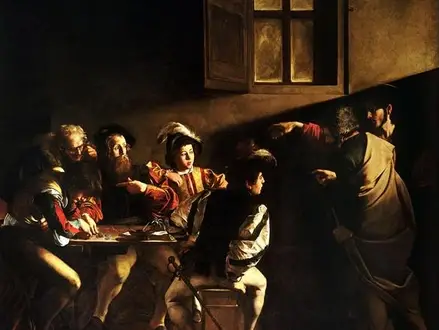Title of Artwork: “Calling of Saint Matthew”

Artwork by Caravaggio
Year Created 1600
Summary of Calling of Saint Matthew
Michelangelo Merisi da Caravaggio’s masterpiece, The Calling of Saint Matthew, depicts the moment Jesus Christ inspires Matthew to follow him. For the Contarelli Chapel in the San Luigi dei Francesi Church in Rome, it was completed between 1599 and 1600. The Martyrdom of Saint Matthew (painted around the same time as the Calling) and The Inspiration of Saint Matthew (both by Caravaggio) are hung next to it (1602).
All About Calling of Saint Matthew
When Cardinal Matthieu Cointerel (in Italian, Matteo Contarelli) died a decade earlier, he left in his will funds and specific instructions for the decoration of a chapel in honour of St Matthew, the patron saint of Cardinals. As a former employer of Caravaggio’s, Cavalier D’Arpino, he was one of Rome’s most popular painters at the time of the chapel’s construction. Since Caravaggio was already a patron of Cardinal Francesco Del Monte, Caravaggio was able to get his first major church commission and his first painting with more than a few figures from Del Monte, who was also the prefect of the Fabbrica of St Peter’s (the Vatican office for Church property).
The Martyrdom of Saint Matthew hangs next to The Calling. The Martyrdom may have been the first, but the Calling was the first to be completed, according to reports. The Calling and the Martyrdom were commissioned in July of 1599, and the final payment was made in July of 1600. The Inspiration of Saint Matthew rests in the middle of the altar, between the two figures (1602).
In the Gospel of Matthew, Matthew 9:9, “Jesus saw a man named Matthew at his seat in the custom house, and said to him, ‘Follow me,’ and Matthew rose and followed Him.” The painting depicts this storey. Matthew the tax collector sits at a table with four other men depicted by Caravaggio. He’s pointing at Matthew, and he’s joined by Jesus Christ and Saint Peter. The faces of the men at the table are illuminated by a beam of light as they gaze at Jesus Christ.
There’s some disagreement over whether or not the bearded man at the table is Saint Matthew, given that his surprised gesture can be interpreted in two ways.
According to most writers on the Calling, the bearded man is St. Matthew, and the bearded man points to himself in response to Christ’s call. Taken together, The Inspiration of Saint Matthew and The Martyrdom of Saint Matthew provide additional support for this hypothesis. All three works feature the bearded man who models as Saint Matthew, and he plays the role of the saint in both “Inspiration” and “Martyrdom”
The bearded man is pointing to the young man at the end of the table, whose head is slumped, according to a more recent interpretation. A young Matthew is about to raise his head to see Christ, and the bearded man in the painting represents the moment just before he does so. The painting has been described as deliberately ambiguous by other critics.
Information Citations
En.wikipedia.org, https://en.wikipedia.org/.























